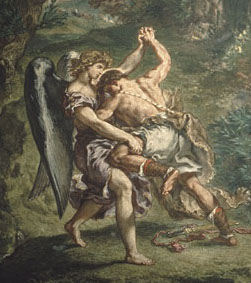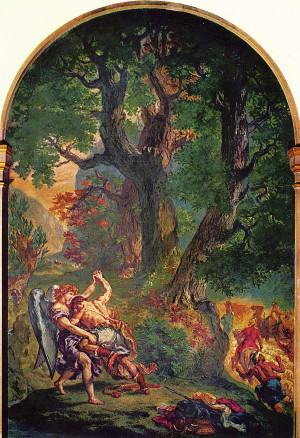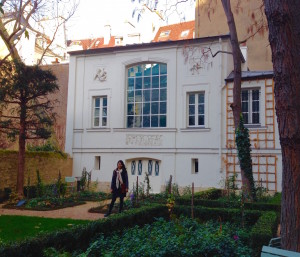 Ferdinand Victor Eugène Delacroix (1798 – 1863) was a French artist who is regarded as the leader of the French Romantic school. For 40 years Eugène Delacroix was one of the most prominent but controversial painters in France. His works were often criticised and scandalising, never the less, he received many official honors and commissions during his lifetime. Complex, contradictory, a rebel, and an outsider, he had a profound and lasting influence on his contemporaries and future generations.
Ferdinand Victor Eugène Delacroix (1798 – 1863) was a French artist who is regarded as the leader of the French Romantic school. For 40 years Eugène Delacroix was one of the most prominent but controversial painters in France. His works were often criticised and scandalising, never the less, he received many official honors and commissions during his lifetime. Complex, contradictory, a rebel, and an outsider, he had a profound and lasting influence on his contemporaries and future generations.
Paris does many things well, and Paris has a real passion for art and culture, the proof of this is the fact that it it offers you over 200 museums to peruse. For me, personal and intimate Paris reveals itself in the unique spaces of the smaller museums. Often situated in the actual houses of extraordinary people who lived a true Parisienne life with passion and inspiration, they include the Musée Marmottan Monet, Musée Rodin, the Musée Gustave Moreau and the Musée Edith Piaf. Extraordinarily, the creation of one work of art – Delacroix’s frescoes in the Saint-Sulpice Church – is the reason we have one of these unique museums to enjoy today.

Delacroix’s first presented his work at the Salon of 1822 (the official Paris art exhibition of the Académie des Beaux-Arts) with La Barque de Dante, now in the Louvre. This is an emotional piece, with powerful, contorted forms and smouldering, vibrant tones. But it is no coincidence that this work was inspired by the written word. During his early career, Delacroix read Shakespeare, Byron, and Scott: he even visited England where he was impressed by Constable’s landscapes. These landscapes are supposed to have influenced Massacre at Chios, shown in 1824. Although this work was criticised by many, the French government purchased it. The immense Death of Sardanapalus was based on a theme by Byron and is remarkable for its theatrical sense and intense color. However, it is a painting inspired by the French Revolution of 1830 that is the most well know of his works today. The iconic Liberty Leading the People in the Louvre is one of the few important works he created that had any connection with contemporary history. Although the scene is certainly set in Paris, you can make out the cathedral of Notre Dame in the background, like most of his works, the interpretation is allegorical.

Although social when young, and due partially to health reasons, as he got older the artist became increasingly reclusive eventually only seeing a few chosen people. Most of this time he was living in the house and using the studio that was to eventually become the Delacroix museum. During his last ten years he exhibited in only one Salon in 1859, and as had happened periodically in his life, his works attracted adverse criticism. However, at the time he had a strong supporter; Baudelaire. He believed Delacroix had essential qualities in his work and was especially impressed by the power of Delacroix’s imagination. Baudelaire stresses the importance of the artist’s confidence in his own creative abilities. Sadly, Baudelaire’s praise was not enough to outweigh the harsh criticism that followed. Indeed, at the opening of his mural in the Chapelle des Anges in the church of Saint-Sulpice, Delacroix bitterly noted that the officials had spurned his invitation to view the work. But times were changing. Baudelaire was not the only one noticing him. New young artists were discovering his innovative works. Without actually looking to collect a following Delacroix was to become a kind of spiritual master for them; some would even go so far as to create a cult like following.

The Musée National Eugène-Delacroix, Place de Fürstenberg in the 6th arrondissement of Paris, is set in the painter’s apartment and his magnificent studio, which is in a delightfully tranquil garden behind the building. Delacroix spent the last years of his life in this haven until his death on August 13, 1863. He was protected from unwanted visitors by his housekeeper, Jenny Le Guillou. He had left his old studio on Rue Notre-Dame-de-Lorette to be nearer the church of Saint-Sulpice where he was in charge of the decorating the chapel. Although he was seriously ill at the time, Delacroix was determined to finish this fresco. He saw it as his artistic and spiritual testament. Painted from 1855 to 1861, today, these frescoes are the main attraction of St-Sulpice. They are in the Chapelle des Anges, on the right just inside the entrance subjects include Jacob wrestling with the angel, St. Michael defeating the devil, and Heliodorus being driven from the temple.

Having no direct heirs, after he died Delacroix wanted his works to be dispersed by public sale. Most of his furniture was also sold. The apartment then had a series of tenants until it was suggested that the studio should be demolished to make way for a garage. At this point, a group of painters, historians and collectors decided to form an association to prevent this destruction. The Société des Amis d’Eugène Delacroix was founded in 1929, with state approval in 1934. When the building was put up for sale in 1952, the Société, who were only tenants, sold their Delacroix collection to the French national museums and used the proceeds to buy the building and garden. The Société then donated it to the State on the understanding that a museum would be created, which now is under the auspices of the Louvre. This intimate setting of Delacroix’s former home provides a perfect backdrop for the paintings, drawings, lithographs and personal objects, which include some of his magnificent souvenirs of Delacroix’s trip to Morocco in 1832. This museum is a wonderful place to visit. It never seems to be really busy, and the garden is a lovely place to sit and contemplate art and life. Highly recommended.
Fascinating. Next time in Paris… Delacroix is a favorite for me, especially for his animals. Thanks!
I agree Ginger. His animals are wonderful. This is a lovely little museum, but the studio is very special.
Pingback:Drawing at the Louvre: A few practical tips – Della Drees